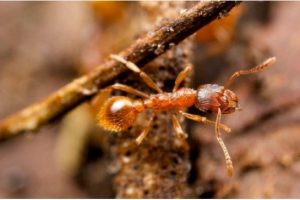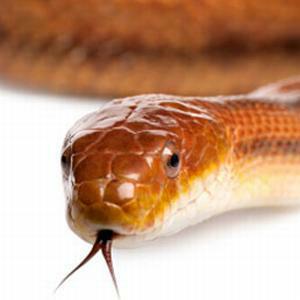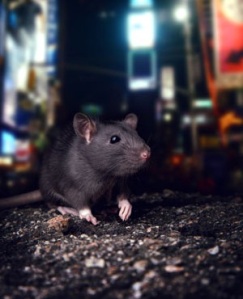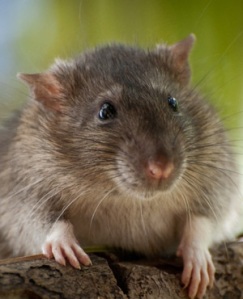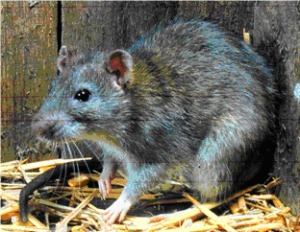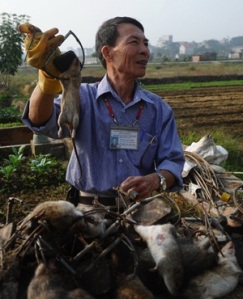
Tran Quang Thieu, nicknamed ‘Rat King’, talks with journalists while holding trapped rats in a field on the outskirts of Hanoi. (Hoang Dinh Nam)
Tran Quang Thieu, otherwise known as the ‘Rat King’, is helping Vietnamese farmers fight off the rice industry’s greatest enemy – rats.
Grinning widely, Tran Quang Thieu brandishes the day’s haul: 10kg of rats caught in rice paddies near Hanoi. A menace to Vietnam’s rice crop, the vermin are regularly trapped – and sometimes eaten.
In his village of Van Binh, on the outskirts of Hanoi, Thieu and his team work night and day in the area’s rice paddies. They estimate 20% of the annual grain crop is lost to hungry rats.
Rice is an essential part of the Vietnamese economy – the communist country is the world’s second largest exporter of the staple grain.
“We used to have to accept the loss of large chunks of our paddies – the rats destroyed it. It made us wonder why we bothered working so hard,” explains 46-year-old farmer Hoang Thi Tuyet.
Rodents can be a determined enemy.
“It’s hard to trap them, they’re clever, they move fast and in Vietnam there are 43 different species of rat to contend with,” Thieu says.
But in 1998, Thieu had a breakthrough – he invented a new kind of rat trap, more effective than anything farmers had previously tried, that worked without bait and relied on extremely strong springs.
Thieu estimates his traps – and his unique rat hunting methods – have since killed millions of rats.
“The agricultural losses caused by rats are enormous – and these rodents can cause fires and explosions by chewing electric cables in houses and factories,” said the septuagenarian.
At least 500 000ha of rice paddy is lost to rats each year, out of some 7.5 million ha planted across Vietnam, said Nguyen Manh Hung of the Institute of Agricultural Sciences.
“Rats cause hundreds of millions of dollars of damage, before we even mention the risk of communicable diseases,” he said.
Family business
So it is no surprise that Thieu – who is known as the “Rat King” for the trap that made him a fortune – is an extremely busy man.
“We get requests to come and catch rats from all over the country but we can’t take them all up, we just don’t have the time,” he said.
His five children have all joined the family business and between them they now run six specialised companies to trap rats.
Some 30 million of his special traps have been sold – they are used throughout Vietnam but also further afield in neighbouring China and Cambodia.
And Thieu doesn’t just sell them to rice farmers either: he’s signed contracts to help hospitals, hotels, restaurants and schools to exterminate pests – even the Hanoi police headquarters.
“Once, we trapped some 300kg of rats in just one night at a tourist resort in Hanoi,” he said proudly.
Over the last few years, the rat population has exploded in Vietnam due to a decline in the population of their natural predators – snakes and cats.
Both serpents and felines are popular delicacies in Vietnam – a country of some 90 million people – and their widespread consumption, thanks in part to an increasingly affluent middle class, has allowed the rat population to grow unchecked.
For this reason, many local authorities are encouraging people to kill rats.
In Thai Binh, just south of Hanoi, authorities are offering farmers cash for rat tails – a means of encouraging them to kill the pests in a simple intervention that protects rice crops without using chemicals.
Grilled or steamed?
In addition, rat hunters can also sell their bounty to restaurants. Paddy rats are widely consumed in the communist country, from the Red River Delta in the north to the country’s rice basket, the Mekong Delta, in the south.
Some of the rats captured by Thieu in his traps are sent to restaurants. Others are given to the farmers whose fields they were caught in, who either eat them or use them to feed their pigs or fish.
“For a long time we’ve eaten rat in Vietnam. Especially since the war, that was when people – mostly farmers – started eating them for want of other meat,” Thieu said.
Paddy rats – a healthier grain fed animal than their city cousins – are prepared in a variety of ways nationwide depending on the province, often grilled or steamed with lemongrass.
“Rat meat is very oily, like suckling pig, and very rich in protein,” said Do Van Phong, sitting in a Hanoi restaurant with two large paddy rats on a plate in front of him.
The dish is popular in Vietnam but there are no official figures on how many restaurants serve it.
But anecdotal evidence suggests it is widely consumed. State media reports that between three and four tons of paddy rats a day is imported from neighbouring Cambodia for the restaurant trade.
According to Phan Phan, a villager in Dinh Bang district in northern Bac Ninh province, rat meat has become a key part of local culture.
“It’s a common dish, it’s good to eat regularly, especially at family occasions – even weddings. People think it helps us to escape bad luck.”







